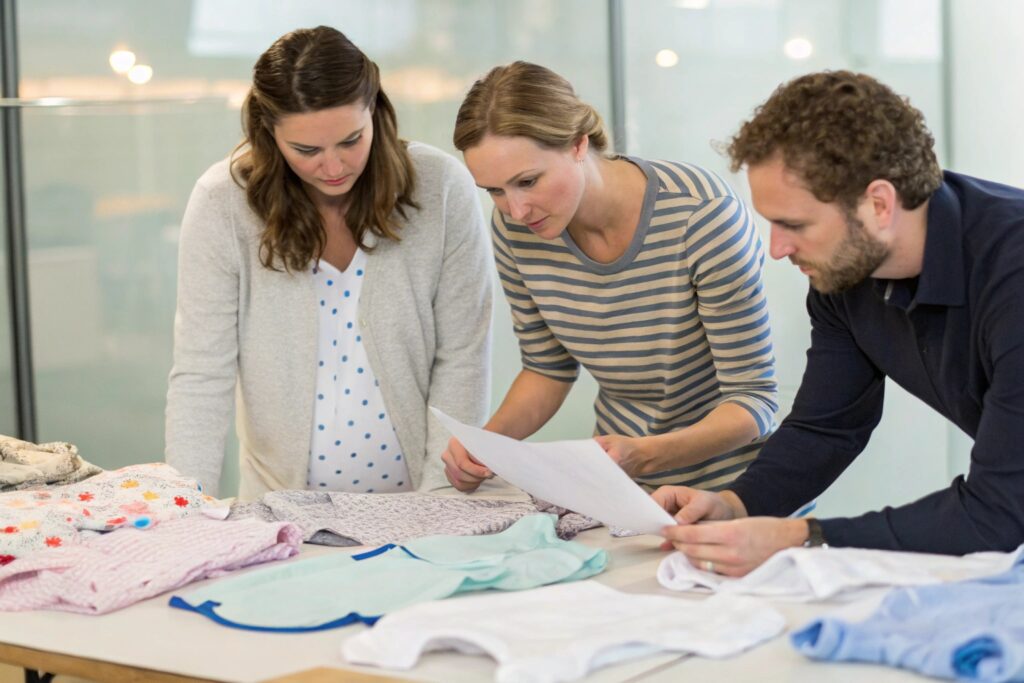Launching a babywear brand in 2025 is full of opportunity—but also full of risk. One of the smartest ways to reduce that risk? Start with low minimums.
Low minimum order quantities (MOQs) give babywear brands flexibility to test products, manage inventory, and grow at a sustainable pace without large upfront investment.
Here’s why low MOQs are not just convenient—they’re essential in today’s market.
How Low MOQs Help Small Babywear Brands Launch Faster?
Starting a new babywear brand used to require thousands of dollars in bulk production. Not anymore.
Low MOQs allow small brands to move quickly from concept to product launch—without needing to order 1,000+ units per style.

Why this flexibility matters for new brands:
- Lower upfront cost = lower financial risk
- Shorter lead times = faster time to market
- Ability to test multiple SKUs in small batches
- More manageable storage—especially for home-based startups
- Cash flow stays fluid instead of being tied up in unsold inventory
| Brand Launch Goal | Low MOQ Benefit |
|---|---|
| Test new styles | Try 100–300 pcs per design |
| Launch multiple sizes | Order just 30–50 pcs per size |
| Start niche collections | Produce seasonal or themed drops only |
| Sell via pre-order | Match MOQ to real demand |
Instead of guessing, low MOQs let you test, learn, and adjust.
Why Retailers Prefer Suppliers with Flexible Order Sizes?
Today’s retailers—from baby boutiques to online marketplaces—want variety without commitment.
Suppliers offering low MOQs attract more wholesale customers by reducing their inventory risk and enabling tighter, trend-driven ordering cycles.

What do modern babywear retailers want?
- Smaller, more frequent deliveries
- The ability to reorder top performers fast
- Space to carry more styles without overstocking
- Seasonal and limited-edition capsules
- Exclusive collections in small runs
| Retail Partner Type | What Low MOQ Offers Them |
|---|---|
| Small shops | Lower order thresholds and upfront cost |
| Subscription boxes | Flexible quantity for curated selections |
| Online marketplaces | More SKU options without overbuying |
| DTC collabs | Made-to-order or fast-turnaround testing |
A supplier with flexible order sizes is easier to do business with—and wins repeat partners.
What Low Minimums Mean for Customization and Testing?
Personalization is a big trend in babywear—but large MOQs make it nearly impossible for small brands to offer it affordably.
Low minimums open the door to customization, exclusive designs, and product testing that builds deeper customer engagement.

What low MOQs enable for creative babywear brands:
- Test a new print, embroidery, or trim on just 100–200 pieces
- Launch personalized babywear with name embroidery or birth details
- Offer limited seasonal drops (e.g. “First Christmas” capsule)
- Gather real customer feedback before scaling
- Run short-run influencer collabs or pop-up collections
| Customization Type | MOQ Sweet Spot |
|---|---|
| Embroidered name sets | 50–100 pcs per variation |
| Holiday capsule collections | 150–300 pcs total across sizes |
| Retailer exclusive design | 200 pcs total (multi-size split) |
Low MOQs give you the freedom to experiment—without the fear of being stuck with unsold stock.
How to Scale Production Gradually Without Excess Inventory?
Not every brand needs to scale fast—but every brand needs to scale smart.
Low minimums let babywear brands increase production in step with sales growth, reducing the risk of overproduction and the pressure of aggressive capital investment.

Steps to scale gradually using low MOQs:
- Start with 100–300 units per style for first launch
- Track sell-through data weekly—identify best sellers early
- Reorder in micro-batches (e.g. 200 pcs every 3 weeks)
- Expand sizes or colors based on customer feedback
- Use pre-orders or waitlists to signal demand before restocking
- Shift to JIT or hybrid production models for core SKUs
| Growth Stage | Recommended Production Approach |
|---|---|
| Launch Phase | 100–300 pcs per SKU (MOQ-level production) |
| Post-validation | 300–500 pcs with faster reorder cycle |
| Scaling phase | Hybrid JIT + core item batching |
This strategy keeps your inventory lean and capital fluid—two key pillars of sustainable growth.
Conclusion
In today’s fast-moving babywear market, low MOQs aren’t just a nice-to-have—they’re a growth strategy. Whether you’re launching your first romper or scaling into seasonal drops, low minimums help reduce risk, improve flexibility, and keep your brand agile. The brands that grow sustainably are the ones who start small, move smart, and scale with purpose.










